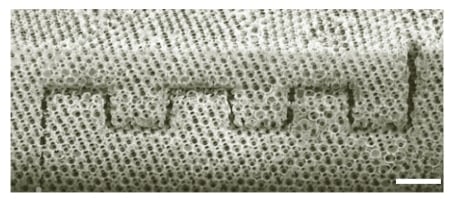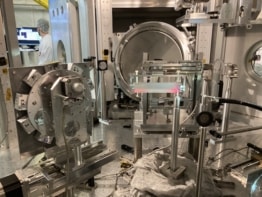
Physicists in the US have created the first true 3D waveguide in a photonic crystal, enabling light to be transmitted around sharp bends. The research is a step towards optical integrated circuits and low-threshold lasers.
A photonic crystal contains regularly alternating regions with high and low refractive indices. This structure creates a “photonic bandgap”, holding back light of certain frequencies while letting light of other frequencies through.
An offshoot of this property is that photonic crystals can confine light to travel along predetermined paths inside waveguides. Such waveguides could be used to process optical signals in telecommunications, or to serve as small laser cavities that only require a low power to start lasing. Unfortunately, nearly all waveguides made so far have been 2D, and until now no-one has come up with a method that can create 3D waveguides at any place within a photonic crystal and with any dimensions so that useful devices can be created.
Marking out
Paul Braun and colleagues at the University of Illinois at Urbana Champaign have pioneered a flexible process for a fabricating 3D photonic-crystal waveguide by using a focused laser to mark it out (Nature Photonics advance online publication).
The researchers begin by crystallizing a colloid of silica spheres either 725 or 925 nm in diameter onto a substrate to create a structure similar to an opal — a well known natural photonic crystal comprising high-refractive-index silicon interspersed with pockets of low-refractive-index air. To this structure they then add a monomer solution, and sweep the focal point of the focused laser beam over the desired waveguide region to make the monomers bond together to form a polymer. With this region now cordoned off, the researchers fill the rest of the structure with silicon and etch away the original silica spheres with acid. (See figure: Method.)
The entire process leaves an “inverse opal” photonic crystal containing a polymer waveguide, which is transparent to near-infrared light, with features less than 100 nm in resolution. To check it works, the researchers made a waveguide with two sharp bends and found that light only with a wavelength of 1.48 µm — corresponding to the photonic bandgap of the material — was transmitted through the waveguide.
Braun’s group says that their method could lead to the first devices that manipulate photons in 3D.



